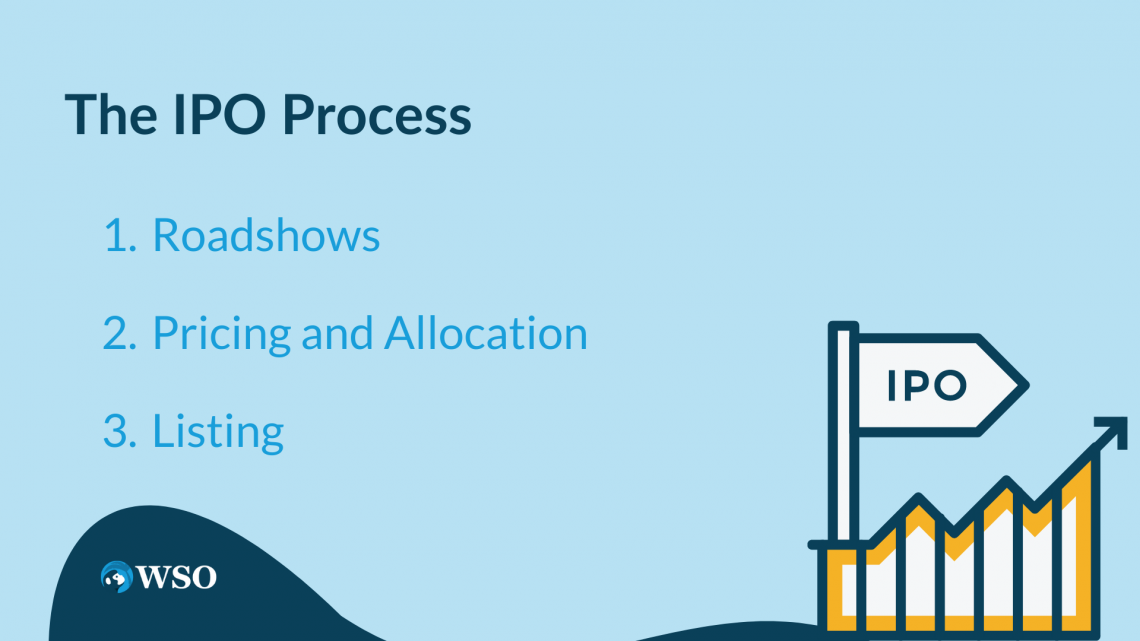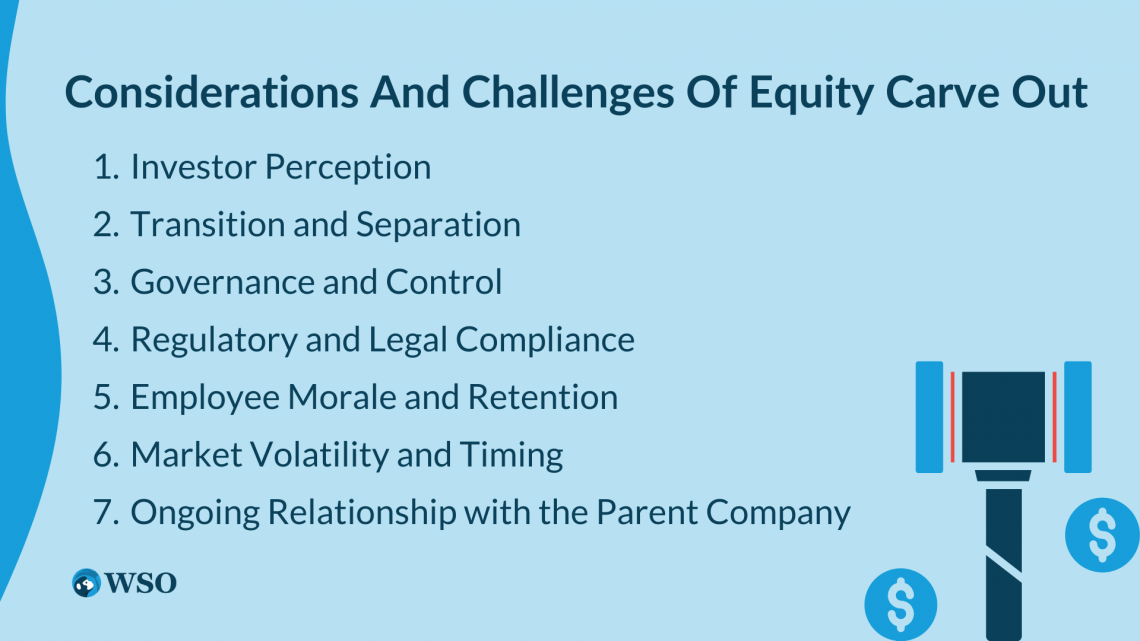Equity Carve-Out
Equity carve-outs involve a parent company selling a portion of its subsidiary's equity to the public through an IPO
What is Equity Carve-Out?
In an equity carve-out, also known as an IPO carve-out or a subsidiary IPO, the parent company sells a portion or all of its interest in a subsidiary to the public in an initial public offering.
In corporate finance, companies constantly seek innovative strategies to optimize their capital structure and unlock hidden value. One such strategic financial move gaining traction is the equity carve-out.

By implementing this strategy, the parent company not only raises capital but also showcases the value of the subsidiary, which may be overshadowed within the broader operations of the parent company.
This strategic move can result in enhanced financial flexibility, increased market value, and better alignment of the subsidiary's operations with its specific business needs.
Equity carve-outs offer a range of benefits, including:
- Capital infusion for the parent company
- Focused operations for the subsidiary
- Recognition of the hidden value
- Opportunities for growth and expansion.

However, executing an equity carve-out requires careful evaluation, meticulous planning, legal and regulatory requirements, adherence, and effective communication with investors.
By understanding this strategic financial move comprehensively, companies can explore new avenues for unlocking value, accessing capital, and positioning themselves for long-term success in today's dynamic business landscape.
Key Takeaways
- Equity carve-outs involve a parent company selling a portion of its subsidiary's equity to the public through an IPO.
- Benefits include capital infusion, value recognition, focused operations, strategic alliances, and unlocking hidden value.
- Effective communication, planning, and engagement of professional advisors are crucial for a successful equity carve-out.
- Investor perception plays a significant role in the success of an equity carve-out, emphasizing the importance of a compelling investment thesis and clear communication.
- Governance and control mechanisms should be established to balance stakeholders' interests while allowing the subsidiary's management autonomy.
Why Perform An Equity Carve-Out?
The parent company "carves out" or separates a minority stake in the subsidiary, offering it as a separate publicly-traded entity while retaining control.

By creating a separate entity for the subsidiary, the parent company can highlight its value, growth potential, and unique market position, which may not be fully recognized within the parent company's operations.
The parent company typically retains a significant stake to maintain control over the subsidiary while allowing public investors to participate in the subsidiary's growth.
However, they also come with considerations and challenges, including investor perception, transition and separation of shared operations, and effective stakeholder communication.
Note
An equity carve-out offers companies a strategic avenue to access capital, optimize their capital structure, and unlock the value of their subsidiary.
They come with considerations and challenges, such as managing investor perception, effectively transitioning and separating shared operations, and maintaining effective communication with stakeholders.
It involves turning a division or subsidiary of a larger organization into a unique, independent business listed on a stock exchange.
Typically, the procedure entails the parent firm issuing shares of the subsidiary or division through an initial public offering (IPO) or another type of public listing.
The parent company may sell a portion of its stake in the subsidiary, generating cash while maintaining control and reaping the benefits of any potential future profit.

Essentially, it entails converting a subsidiary or division of a bigger corporation into a distinct, independent company listed on a stock exchange.
Some common motivations include:
- Unlocking the value of an underappreciated subsidiary
- Raising capital for the parent company's other business activities
- Reducing debt
- Improving focus on core operations
- Providing a separate platform for subsidiary management to pursue independent strategies
- Incentivizing subsidiary management through stock ownership.
The subsidiary's shares are normally allocated to the shareholders of the parent business or sold to the public, allowing investors to participate in the subsidiary's performance and prospective development possibilities.
Note
It's crucial to remember that stock carve-outs can be complicated transactions with legal, regulatory, and accounting implications. They need thorough planning and analysis to guarantee that the desired goals are achieved for both the parent firm and the newly formed subsidiary.
Benefits of Equity Carve-Out
Equity carve-outs offer several benefits to the parent company and the subsidiary.

Some of the key advantages are:
1. Capital Infusion
One of the primary benefits of an equity carve-out is the ability to raise capital. This capital infusion can enhance the financial position and flexibility of the parent company.
2. Value Recognition
Equity carve-outs enable the market to recognize and assign a more accurate value to the subsidiary. Often, the value of a subsidiary might be overshadowed or undervalued within the parent company's diversified operations.
By creating a separate publicly-traded entity, the market can more effectively evaluate the subsidiary's financials, growth potential, and industry dynamics. This can lead to increased investor attention and potentially result in higher valuation multiples for both the parent and subsidiary.
Note
Creating a separate entity can lead to increased investor attention and potentially result in higher valuation multiples for both the parent and subsidiary
3. Focused Operations
Carving out a subsidiary as a separate entity gives its management team greater focus, autonomy, and flexibility to make strategic decisions tailored to the subsidiary's needs.
This focused approach can lead to improved operational efficiency, better alignment with the subsidiary's objectives, and the ability to react swiftly to market changes.
It allows the subsidiary to have its dedicated management structure, enabling quicker decision-making and agility in pursuing growth opportunities.
4. Strategic Alliances and Partnerships
Creating a distinct corporation via an equity carve-out can pave the way for strategic alliances and collaborations.
Note
As a separate corporation, the subsidiary can enter into partnerships, joint ventures, or other commercial arrangements with third parties, exploiting its particular capabilities and market positioning, potentially leading to synergies and new growth opportunities.
5. Unlocking Hidden Value
In certain circumstances, a subsidiary's real value or development potential may not be completely appreciated inside the parent company's operations.
An equity carve-out can give a platform for the market to evaluate and appreciate the subsidiary's distinct characteristics, resulting in a higher valuation and enhanced shareholder value. This might benefit both the parent firm and the investors in the subsidiary.
Note
It's vital to remember that the advantages of equity carve-outs might vary depending on the conditions and market reaction.
To make an educated decision, companies seeking an equity carve-out should carefully weigh the possible benefits against the accompanying risks and obstacles.
Process of an Equity Carve-Out
The process of an equity carve-out involves several stages and considerations. A general overview of the steps involved are:

1. Evaluation and Planning
The parent company begins by evaluating an equity carve-out strategic rationale and feasibility. This involves assessing the subsidiary's financial performance, growth prospects, and market dynamics.
The parent company should determine if an equity carve-out aligns with its long-term goals and if it is the appropriate strategy to unlock value.
2. Legal and Regulatory Considerations
Compliance with legal and regulatory requirements is crucial throughout the equity carve-out process. The parent company engages legal advisors to navigate securities laws, disclosure obligations, and corporate governance rules.
Note
They must ensure adherence to relevant regulations and obtain necessary approvals from regulatory authorities.
3. Financial Preparation
The subsidiary's financials are prepared for public scrutiny. The parent company typically hires accounting and financial experts to audit the subsidiary's financial statements, ensuring transparency and accuracy.
This may involve restructuring the subsidiary's balance sheet, addressing contingent liabilities, and presenting the financials in a format suitable for potential investors.
4. IPO Process
The initial public offering (IPO) is a critical phase of the equity carve-out. The subsidiary is registered for the IPO, and a prospectus is drafted, providing detailed information about the subsidiary's business, financials, risks, and growth prospects.
Note
The parent company may engage investment banks as underwriters to assist with the offering.
The IPO process
The process by which a private company offers its shares to the public for the first time is known as the Initial Public Offering (IPO). It enables the company to raise capital by selling ownership stakes in the form of shares to investors.

The IPO process consists of several steps that typically necessitate the assistance of investment banks, legal counsel, and regulatory bodies. The following is a high-level overview of the IPO process:
a. Roadshows
The subsidiary's management team and investment bankers conduct presentations and meetings with potential investors to generate interest in the offering. These roadshows aim to communicate the investment thesis, growth prospects, and the value proposition of the subsidiary.
b. Pricing and Allocation
Based on investor demand and market conditions, the underwriters and the parent company determine the offering price and allocate shares to institutional and retail investors.
Note
The pricing is a crucial decision, as it influences the market valuation of the subsidiary.
c. Listing
Once the pricing and allocation are finalized, the subsidiary's equity is listed on a stock exchange. The shares become tradable, and the subsidiary starts trading separately.
5. Post-IPO Considerations
After completing the equity carve-out, the parent company retains a significant stake in the subsidiary, ensuring it maintains control.
The parent company and the subsidiary's management team monitor the subsidiary's performance, communicate with investors, and fulfill ongoing regulatory obligations.
They may also establish agreements and contracts to govern the relationship between the parent company and the subsidiary.
Note
The involvement of financial and legal advisors is crucial to navigating the complexities and ensuring a smooth and successful equity carve-out.
Companies contemplating an equity carve-out should carefully assess each step, conduct thorough due diligence, and seek expert advice to execute the process and achieve their strategic objectives effectively.
Considerations and Challenges of Equity Carve-Out
Executing an equity carve-out presents various considerations and challenges that companies should carefully evaluate. Some of the key considerations and challenges include:

1. Investor Perception
The success of an equity carve-out depends on how investors perceive the subsidiary as a separate entity. Factors such as the subsidiary's financial performance, growth prospects, competitive positioning, and market dynamics can influence investor interest and valuation.
The parent company must effectively communicate the investment thesis and articulate the value proposition of the subsidiary to generate investor confidence.
2. Transition and Separation
Carving out a subsidiary requires separating shared operations, systems, and resources from the parent company. This transition process can be complex and challenging, involving disentangling contracts, realigning staff, and establishing independent infrastructure.
Note
Effective planning, project management, and clear communication are crucial to minimize disruptions and ensure a smooth separation.
3. Governance and Control
While the parent company retains a controlling stake in the subsidiary, it must carefully manage the governance structure and balance the interests of various stakeholders.
Note
Clear agreements and contracts should be established to govern the relationship between the parent company and the subsidiary.
The parent company needs to ensure appropriate oversight and control mechanisms are in place while allowing the subsidiary's management team the autonomy to operate independently.
4. Regulatory and Legal Compliance
Equity carve-outs involve navigating various legal and regulatory requirements, including securities laws, disclosure obligations, and corporate governance rules.
Note
Engaging legal advisors with securities and corporate law expertise is essential to navigating the regulatory landscape effectively.
5. Employee Morale and Retention
Maintaining employee morale and retaining talent is vital for the subsidiary's success. Transparent communication, appropriate incentives, and career development opportunities can help mitigate concerns and retain key employees.
6. Market Volatility and Timing
Market conditions and investor sentiment can influence the success of an equity carve-out. Volatility in the financial markets, economic conditions, or industry-specific factors can impact investor appetite for the offering.
Note
Choosing the right timing for the carve-out, when market conditions are favorable, and industry prospects are promising, can increase the likelihood of a successful IPO.
7. Ongoing Relationship with the Parent Company
Following the equity carve-out, the parent company maintains a significant stake in the subsidiary.
Establishing a strong ongoing relationship between the parent and subsidiary is essential, including clear communication channels, shared strategic objectives, and alignment on key decision-making processes.
Maintaining a collaborative and supportive relationship can contribute to the subsidiary's long-term success. Each of these considerations and challenges requires careful analysis and planning to mitigate risks and maximize the benefits of equity carve-out.
Companies should conduct thorough due diligence, engage experienced professionals, and develop a comprehensive strategy to address these aspects effectively.




or Want to Sign up with your social account?